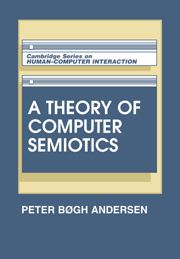 A Theory of Computer Semiotics
A Theory of Computer Semiotics Book contents
- Frontmatter
- Contents
- Preface to second edition
- PART I THEORY
- PART II COMPUTERS
- PART III LANGUAGE, WORK, AND DESIGN
- Introduction
- III.1 Language as interpretation. Semantic fields in the Postal Giro
- III.2 Language as action. Language games in the Postal Giro
- III.3 Task analysis. Controlling control.
- References
- Index
Introduction
Published online by Cambridge University Press: 26 March 2010
- Frontmatter
- Contents
- Preface to second edition
- PART I THEORY
- PART II COMPUTERS
- PART III LANGUAGE, WORK, AND DESIGN
- Introduction
- III.1 Language as interpretation. Semantic fields in the Postal Giro
- III.2 Language as action. Language games in the Postal Giro
- III.3 Task analysis. Controlling control.
- References
- Index
Summary
In Part I of this book I presented a general framework for understanding language and computers, and in Part II showed how to apply this framework to analysis and design of computer systems. What remains to be done now is to broaden the scope of our analysis, and show how the same framework can be used for describing and designing computer systems in a practical context of work. In order to do that I need a concrete example, and I shall use data from the 1986 project at the Postal Giro Office in Stockholm, “Professional language in change”, mentioned in Section 1.1.1.
Before I start on this last stage of the journey, I think it would not be out of place to make a short summary of what has been accomplished so far.
Although the theoretical framework of the book is not natural science but a structuralist tradition of semiotics and linguistics, the project of the book is a part of an ongoing paradigm change in computer science itself: from seeing the computer system as a self-sufficient mathematical object, the focus is gradually being shifted to the relations between system and work context. An important practical motivation for this shift is simply that it hopefully will enable us to construct computer systems that meet the needs of the users in a better way. However, the shift is also theoretically motivated by the structuralist framework, since structuralism is characterized by focusing on relations, not on objects, as the real existing phenomena.
- Type
- Chapter
- Information
- A Theory of Computer SemioticsSemiotic Approaches to Construction and Assessment of Computer Systems, pp. 332 - 340Publisher: Cambridge University PressPrint publication year: 1991
